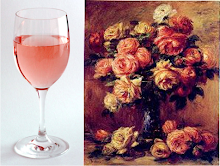.
Note: Here's an interesting old recipe. We're not sure if it will really work, so we're providing this to you just for your information. If you are knowledgeable and experienced in making your own own wine, you are welcome to try or tweak this recipe but please do so at your own risk.
To make six gallons of wine, gather about six to seven pounds of flowers that are sweet scented, using only the petals and, in the case of roses, the hips.
Boil them in six gallons of water until the flavor is completely extracted. Squeeze the whole brew through a piece of canvass cloth and transfer to a clean container.
For every gallon, add two pounds of clarified lump sugar. Add the rinds and juice of ten lemons and 1/4 ounce of cinnamon.
Mix everything together thoroughly and transfer to a cask that has been prepared and cleaned. Let the mixture stand -- several days if necessary -- until all impurities have settled to the bottom.
When you are ready to transfer to bottles, first put one wineglassfull of brandy or rum in each bottle then fill with the mixture. Give it time to age. After a couple of months or so, it will turn into a nice fancy rose wine.
You can also do this with any sweet-scented flower: jasmine, magnolia, or gummamela (hibiscus), just to name a few.
Thursday, August 21, 2008
A rose is a many splendored thing
.
Roses are loved not only loved for their beauty and sweet frangrance, they also have been imbibed and eaten, literally, since ancient times.
As early as 3000 B.C., roses were made into wine by the Romans.
In 18th century England, people ate salads with rose petals in them, as well as ice cream flavored with essence of roses.
In India, kings bathed in water strewn with rose petals, and rose water and rose oil were used for medicinal purposes, including digestive aids.
Today, rose oil is used in syrups, as well as perfumes and cosmetics.
Vino Escarlata is proud and happy to be part of the tradition of making good things out of roses. In this case, it's scarlet wine from roses.
Roses are loved not only loved for their beauty and sweet frangrance, they also have been imbibed and eaten, literally, since ancient times.
As early as 3000 B.C., roses were made into wine by the Romans.
In 18th century England, people ate salads with rose petals in them, as well as ice cream flavored with essence of roses.
In India, kings bathed in water strewn with rose petals, and rose water and rose oil were used for medicinal purposes, including digestive aids.
Today, rose oil is used in syrups, as well as perfumes and cosmetics.
Vino Escarlata is proud and happy to be part of the tradition of making good things out of roses. In this case, it's scarlet wine from roses.
Notes: Wine, alcohol, and you
.
* Wine is not for everyone. Certain medical conditions are worsened by the consumption of wine.
* Next to caffeine, alcohol is the most abused legal drug of choice for people wishing to alter their energy level and their mood.
* Drinking alcohol might be fine in moderation, but the fact is, alcohol has a very narrow therapeutic window.
* People with medical and social conditions worsened by alcohol should not consume any alcohol at all.
* Binge drinking is more responsible for beer bellies than beer itself. Therefore, the unhealthy beer belly, or ‘beer gut’, might be better known as a ‘binge belly.’
* In Spain, the first bottles of a white wine that is almost alcohol-free went on sale this month (August 2008). It is made from the Muscat grape, using a spinning cone that extracts the alcohol from wine and reduces the alcohol content to 0.5%.
* Wine is not for everyone. Certain medical conditions are worsened by the consumption of wine.
* Next to caffeine, alcohol is the most abused legal drug of choice for people wishing to alter their energy level and their mood.
* Drinking alcohol might be fine in moderation, but the fact is, alcohol has a very narrow therapeutic window.
* People with medical and social conditions worsened by alcohol should not consume any alcohol at all.
* Binge drinking is more responsible for beer bellies than beer itself. Therefore, the unhealthy beer belly, or ‘beer gut’, might be better known as a ‘binge belly.’
* In Spain, the first bottles of a white wine that is almost alcohol-free went on sale this month (August 2008). It is made from the Muscat grape, using a spinning cone that extracts the alcohol from wine and reduces the alcohol content to 0.5%.
Subscribe to:
Posts (Atom)
